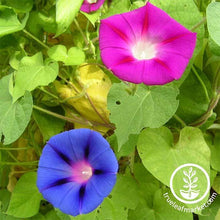112 days. Mixed Colors morning glory seeds are an essential and decorative grow for your summertime garden, home, or patio. Mixed Colors morning glory is easy to grow from seed and produces hardy and vigorous vines bursting with 2" trumpet-shaped blooms that climb as high as 5 – 10' up fences, sidings, trees, and trellises. Mixed Colors morning glories are an ideal interior décor to shape around windows, doors, and corners or to have sprawl freely out on the porch or patio. Mixed Colors morning glory seeds grow a variable habit left to the creativity and imagination of the gardener to shape, mound, mold, or fold the climbing plant however they'd like to for the season.
Growing Mixed Color Morning Glory Garden Seeds
- Taxonomy: Ipomoea purpurea
- Other Names: Common Morning Glory, Tall Morning Glory
- Seed Type: Annual
- Sow Indoors or Outdoors: Seeds can easily be sown outside directly after the frost but, for earliest blooming, start Mixed Colors morning glory seeds indoors 6 – 8 weeks prior and transplant once there are two sets of true leaves. Morning glory seeds are quick to germinate and then harden off seedlings for a week or two before transplanting with early growth and trellis support. Without climbing support, Mixed Colors morning glories will mound and spread horizontally rather than vertically. Plants can just as easily vine and climb indoors as they can outdoors.
- Days to Maturity: 112 days
- Hardiness Zone: 2 – 11
- Planting Depth: Plant 2 – 3 seeds ¼” deep
- Plant Spacing: 12 – 36” depending on desired growth habit
- Growth Habit: Morning glories have a variable growth habit dependent on trellis support. With early growth support, plants can vine as high as 60 – 120” tall bursting with 2” trumpet-shaped blooms. Without trellis support, plants will only mound 12 – 15” tall and spread their blooms 36 – 60” wide.
- Soil Preference: Average, consistently moist, well-drained
- Light Preference: Full sun
- Diseases/Pests/Troubleshooting: Mixed Colors morning glory seeds are native to Mexico and South America and tolerant of gardens in similar climates prone to heat, drought, and poor soils. Morning Glory has no serious pests but monitor for spider mites, especially in dry weather.
- Color: A seasonal mix of shades in blue, purple, fuchsia, and rose
-
Seeds Per Package:
- 1 oz - Approximately 850 Seeds
- 4 oz - Approximately 3,400 Seeds
- 1 lb - Approximately 13,600 Seeds
Seeds can easily be sown outside directly after the frost but, for earliest blooming, start Mixed Colors morning glory seeds indoors 6 – 8 weeks prior and transplant once there are two sets of true leaves. Morning glory seeds are quick to germinate and then harden off seedlings for a week or two before transplanting with early growth and trellis support. Without climbing support, Mixed Colors morning glories will mound and spread horizontally rather than vertically. Morning glories have a variable growth habit dependent on trellis support. With early support, plants can vine as high as 60 – 120” tall bursting with 2” trumpet-shaped blooms. Without trellis support, plants will only mound 12 – 15” tall and spreading their blooms 36 – 60” wide. Plants can just as easily vine and climb indoors as they can outdoors. Plant 2 – 3 Mixed Color morning glory seeds ¼” deep and 12 – 36” apart (depending on desired growth habit) in average, consistently moist, and well-drained soil in full sun. Mixed Colors morning glory seeds are native to Mexico and South America and tolerant of gardens in similar climates prone to heat, drought, and poor soils. Morning Glory has no serious pests but monitor for spider mites, especially in dry weather. Mixed Colors morning glory seeds mature in 112 days bursting with 2" trumpet-shaped blooms in a seasonal mix of blue, purple, fuchsia, and rose.
Ipomoea purpurea, or more commonly known as Morning Glory, is a vining variety native to Mexico and various regions of Central and South America. Annual morning glories are often mistaken for their perennial cousin Convolvulus arvensis, or Field Bindweed, which is an aggressive and invasive weed native to Europe. Although they look practically identical, the key to differentiating morning glory from field bindweed is whether or not the plant withstands frost; morning glory does not have the deep root systems like field bindweed to withstand any longterm chill.



